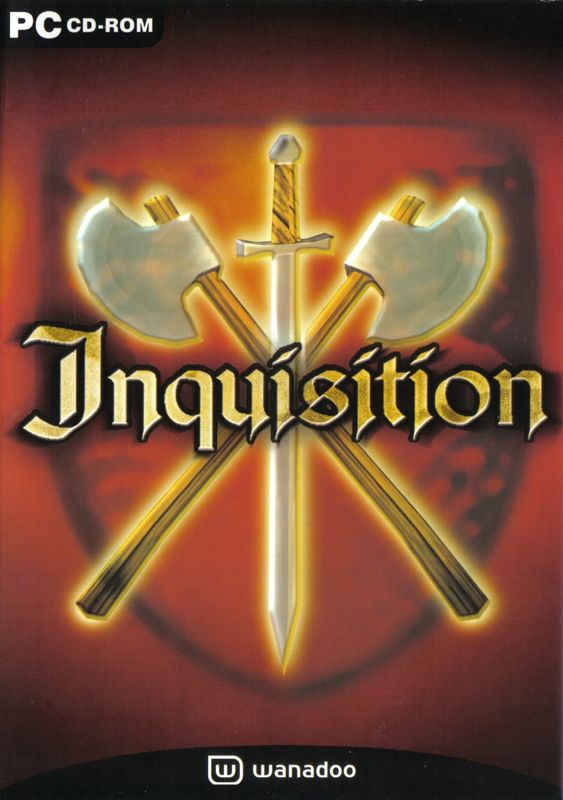Retro Replay Review
Gameplay
Inquisition places you squarely in the shoes of Matthew, a nimble thief whose only hope of survival lies in his ability to blend into the shadows and strike when the moment is right. From the moment you escape the dank prison cell, you’ll find yourself making split-second decisions: should you pick a lock quietly, feign innocence in a torchlit alley, or lash out with your dagger? The core mechanics emphasize a delicate balance between stealth and combat, ensuring that every rooftop leap, lock‐pick attempt, or desperate counterattack feels consequential.
(HEY YOU!! We hope you enjoy! We try not to run ads. So basically, this is a very expensive hobby running this site. Please consider joining us for updates, forums, and more. Network w/ us to make some cash or friends while retro gaming, and you can win some free retro games for posting. Okay, carry on 👍)
The game’s level design shines by weaving together cramped Parisian back alleys, sprawling market squares and claustrophobic sewer tunnels below the city. Each area is populated by vigilant guards, unsuspecting civilians, and lurking dangers that can instantly snuff out your progress. Fortunately, Inquisition rewards careful planning. Distractions like tossing coins, creeping behind obstructions, and timed takedowns make you feel like a true master thief rather than just a button-masher.
As you advance through the chapters, enemy placement and patrol patterns grow increasingly complex. Early levels let you learn the ropes with fewer adversaries, but soon you’ll contend with torch-bearing sentries equipped with crossbows, vicious guard dogs, and even rival bandits who threaten both your life and your treasure hunt. With keyboard‐only controls—no mouse support—the game leans on responsive keybindings for movement, weapon selection and lock‐picking, demanding a degree of muscle memory that hardcore stealth veterans will appreciate.
Graphics
Inquisition captures 14th-century France with grit and authenticity. Dimly lit alleyways are painted in muted tones of gray and brown, while the flicker of torches casts shadows that dance across crumbling stone walls. The environment art excels at evoking the era’s cruelty and hardship—every patched cloak on a beggar and rotting wood plank in a sewer tunnel reinforces the sense of desperation that permeates medieval Paris.
Character models are detailed, with clothing textures that show the wear of constant use and grime. Matthew’s leather armor creaks as he shifts position, and guards’ breastplates reflect torchlight in a convincing manner. Facial animations during cutscenes convey fear, guilt and determination, though a handful of side NPCs occasionally display stilted lip-syncing. Overall, the artistic direction balances realism with a slightly stylized edge to ensure visibility during night-time stealth segments.
Performance is generally stable on modern Windows rigs, holding a solid frame rate even in the most crowded market scenes. Occasional stutters can occur when loading new sewer chambers or during large fight sequences, but they rarely hamper the overall experience. The UI design is minimalist: a small stamina meter, a lock-picking progress bar and subtle indicators for nearby enemies. This clean presentation keeps your focus on sneaking and exploration rather than on cluttered HUD elements.
Story
Set against the backdrop of the Holy Inquisition’s ruthless campaign across France, Inquisition’s narrative dives into themes of survival, faith and betrayal. You begin as Matthew, a petty thief with little more than a hunger for his next meal—and quickly find yourself entangled in the legend of the Templar Knights’ hidden treasure. This central mystery fuels your motivations and drives you forward, with each cryptic clue and forgotten manuscript deepening your resolve.
Supporting characters include a mysterious informant in the seedy taverns of Paris, an exiled noblewoman with her own vested interest in the ancient relics, and a zealous inquisitor on the trail of heresy. Dialogue between these figures feels authentic to the period, peppered with medieval vernacular yet accessible to modern players. Key plot twists—like uncovering clandestine meetings in underground chapels—heighten the stakes and force Matthew to question who he can truly trust.
Narrative pacing is well-measured: early missions focus on tutorial‐style objectives and basic heists, while later chapters delve into darker conspiracies and moral dilemmas. Interspersed cutscenes are fully voiced and feature atmospheric music, adding to the immersion. Though the overarching quest for the Templar treasure can feel familiar to fans of historical action-adventure games, the Inquisition’s setting and period-accurate details lend it a fresh, compelling spin.
Overall Experience
Inquisition offers a robust stealth-action adventure that will appeal to fans of methodical gameplay and historical atmospheres. Learning to navigate the game’s keyboard-driven control scheme takes time, but once you’ve mastered the timing of your lock-picks and the rhythm of your silent takedowns, each successful infiltration delivers a gratifying sense of accomplishment. The game’s difficulty curve is challenging without being punishing, making every narrow escape a story worth retelling.
While occasional technical hiccups—minor frame drops, rare collision bugs—might pull you out of the moment, they’re outweighed by the depth of the world and the intensity of the missions. The combination of rooftop pursuits, gritty street brawls, and candlelit crypt explorations keeps the experience varied. You’ll find yourself pausing to admire the hand-painted cathedral ceilings or to map out the fastest escape route when alarms are triggered.
For players seeking a dark, atmospheric journey through medieval France with a healthy dose of stealth, Inquisition delivers on nearly every front. Its evocative visuals, richly woven narrative and satisfying gameplay loops make it a strong contender in the historical action-adventure genre. Whether you’re slipping past guards in the dead of night or unraveling the Templar Knights’ greatest secret, this title offers an engrossing experience you won’t soon forget.
 Retro Replay Retro Replay gaming reviews, news, emulation, geek stuff and more!
Retro Replay Retro Replay gaming reviews, news, emulation, geek stuff and more!









Reviews
There are no reviews yet.